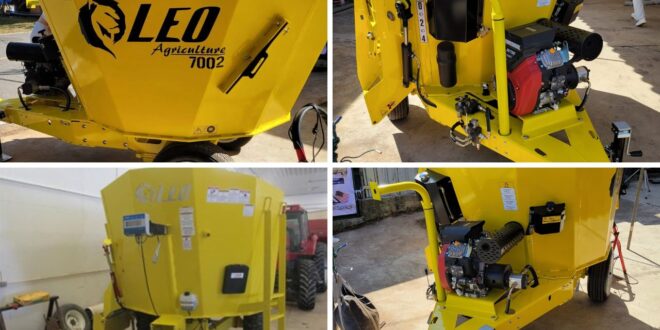How Does a Feed Mixer Work? Feed Mixer livestock with a balanced diet is essential for healthy growth and productivity. Feed mixers play a critical role in achieving this balance by thoroughly blending various ingredients to create a nutrient-rich feed mixture. But how exactly does a feed mixer work? Let’s explore the fundamentals of feed mixers, the types available, and the process that ensures every bite of feed contains an ideal mix of nutrients.
Feed Mixers: What Are They?
A feed mixer is a machine specifically designed to blend a variety of feed ingredients into a homogenous mixture, providing livestock with consistent nutrition. The aim of a feed mixer is to prevent “sorting” or selective feeding, where animals pick out their preferred ingredients rather than eating the complete, nutritionally balanced diet. With feed mixers, farmers can create customized feed recipes based on the dietary needs of their livestock, whether it be cattle, pigs, poultry, or other animals.
Feed mixers come in various types and sizes, from small models suitable for small-scale farms to larger industrial models capable of mixing tons of feed at once.
Types of Feed Mixers
There are three primary types of feed mixers, each serving different purposes and suited for various farm sizes and types of feed. Understanding the differences can help farmers choose the right mixer for their operation.
1. Vertical Feed Mixers
Vertical feed mixers are one of the most popular types and are often used on medium to large farms. They operate with a vertical auger, a large screw that rotates vertically in the mixer, pulling ingredients from the bottom to the top. The auger continuously moves the ingredients through the mixer, breaking up clumps and ensuring an even blend of materials.
Advantages of Vertical Mixers:
- Cost-effective and generally less expensive.
- Simple design, easy to clean and maintain.
- Effective at mixing high-fiber feeds and forages.
Disadvantages:
- Limited to certain ingredients; may not perform well with very fine or wet ingredients.
- Not as effective for extremely large-scale operations.
2. Horizontal Feed Mixers
Horizontal mixers are particularly suited for high-capacity operations, as they provide a faster mixing process. These mixers typically have one or more horizontal augers that move ingredients back and forth, creating a thorough and uniform blend. Horizontal mixers are often used in larger commercial farms or feed production facilities.
Advantages of Horizontal Mixers:
- Suitable for a wider range of ingredients, including fine powders and liquids.
- Provides a faster, more uniform mix.
- Larger capacity, making them ideal for large farms.
Disadvantages:
- Higher cost and maintenance requirements.
- May be harder to clean, especially with sticky or wet feeds.
3. TMR (Total Mixed Ration) Feed Mixers
TMR mixers are designed specifically to prepare a Total Mixed Ration, which is a blend of all necessary nutrients needed by the livestock in every mouthful. TMR mixers are versatile and can handle a wide variety of feed components, including grains, forages, vitamins, and minerals. This type of mixer ensures livestock cannot selectively eat only certain components of the feed, thereby promoting a balanced diet.
Advantages of TMR Mixers:
- Provides the most balanced, nutrient-dense feed per bite.
- Reduces feed waste and selective feeding.
- Versatile, handling a wide range of ingredients.
Disadvantages:
- Typically more expensive due to their versatility and capacity.
- May require more space and power to operate efficiently.
How Does a Feed Mixer Work?
Feed mixers operate through a combination of mechanical motion and advanced design. Here’s a step-by-step breakdown of the basic process of how a feed mixer works:
1. Loading Ingredients
The first step in the mixing process is loading the feed ingredients into the mixer. Ingredients can include grains, silage, hay, protein meals, minerals, vitamins, and sometimes even liquids like molasses for added palatability. The proportions of these ingredients vary depending on the type of animal and its specific nutritional requirements.
2. Auger Action and Mixing
The auger, whether vertical or horizontal, is the heart of the feed mixer. Once the ingredients are loaded, the auger starts rotating, moving the ingredients through the mixer. In a vertical mixer, the auger pulls the ingredients from the bottom, lifts them to the top, and then allows them to fall back down to mix thoroughly. In a horizontal mixer, the augers push ingredients back and forth, ensuring an even blend.
As the augers rotate, they create a continuous motion, breaking down any clumps and ensuring that all particles are uniformly distributed throughout the mixture. This motion is essential for achieving a homogenous blend that provides equal nutrients in every bite.
3. Blending and Additive Distribution
For many farmers, additional additives such as vitamins, minerals, or medication are added during the mixing process. These ingredients are added at specific times, ensuring they are thoroughly blended without settling or clumping. Proper distribution of these additives ensures each animal receives the required nutrients without inconsistencies.
4. Discharge and Distribution
Once the feed is adequately mixed, the final step is discharging it from the mixer. Most mixers are designed to discharge feed from a side or bottom opening, allowing it to be directly deposited into a feeding trough or another storage container. This step is crucial for efficient feeding, as the even distribution prevents animals from sorting or picking specific ingredients.
Some advanced mixers may even be equipped with automated feeding systems that deliver the feed directly to animals, streamlining the feeding process.
Factors to Consider When Choosing a Feed Mixer
Choosing the right feed mixer is critical for ensuring efficient, cost-effective feeding on the farm. Here are some key factors to consider:
1. Type of Feed
Different types of feed require different mixing capabilities. For instance, a vertical mixer may be more suitable for high-fiber feeds, while a horizontal mixer might work better with fine ingredients. If the feed includes a large proportion of grains or powdered ingredients, a horizontal mixer may be more efficient.
2. Capacity
The mixer should be able to handle the volume of feed needed for the farm’s livestock. Small farms may only need a compact vertical mixer, while large operations require high-capacity TMR or horizontal mixers that can handle tons of feed at a time.
3. Power Requirements
Feed mixers can vary significantly in terms of power consumption. Large horizontal and TMR mixers may require more power, whereas vertical mixers tend to consume less. Choosing a mixer compatible with the farm’s power infrastructure can help avoid unnecessary costs.
4. Maintenance and Cleaning
Ease of cleaning is also an important consideration. Mixers that handle sticky or wet feeds may require more frequent cleaning to prevent residue buildup, which can affect mixing efficiency and machine longevity.
Maintenance Tips for Feed Mixers
To keep a feed mixer running efficiently and prolong its lifespan, regular maintenance is essential. Here are some tips for maintaining a feed mixer:
- Regular Cleaning: Clean the mixer regularly to prevent feed residue from building up, which can affect mixing efficiency and encourage mold growth.
- Check Augers and Blades: Inspect the augers and blades for wear or damage. Replace any worn parts to ensure consistent performance.
- Lubricate Moving Parts: Apply lubrication to all moving parts according to the manufacturer’s guidelines. This helps prevent friction and reduces wear and tear.
- Inspect Electrical Components: Ensure all electrical components are functioning properly, especially if the mixer is automated or has electronic control systems.
Conclusion
Feed mixers play an indispensable role in modern farming by helping farmers prepare a balanced and uniform diet for their livestock. By blending a variety of ingredients into a single, nutrient-dense feed mixture, these machines promote healthier animals and more efficient feeding practices. Whether a farm requires a vertical, horizontal, or TMR mixer, understanding how these machines work can help make informed decisions that benefit both the animals and the farm’s bottom line.
 New Anozo We Share Human Helpful Content
New Anozo We Share Human Helpful Content



